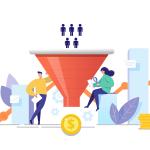Emotions and biases can and do influence our buying decisions (whether we realize it or not). A brand name, special offer, and immediate gratification can make a deal much sweeter. Eight out of 10 buying decisions we make are based on emotion. So with just 20 per cent of these decisions devoted to pure logic, it only makes sense for marketers to know the psychological factors that sway us toward a specific brand or product.
Ultimately, marketers should account for cognitive biases that can work for or against their brand. This infographic explains common biases that influence consumers’ purchasing decisions, including the status quo bias, the loss aversion bias, and the ingroup bias. It also includes strategies to convert more customers by tapping into psychological principles. Read on for psychology-based tips and takeaways to shape your sales marketing strategy.
The Role Emotions Play on Purchasing Decisions
- Buying decisions are based on:
- 20% logic
- 80% emotion
- Research conducted by the Advertising Research Foundation concluded
- The emotion of likeability is the most predictive of whether or not an advertisement will increase a brand’s sales
- fMRI neuro-imagery shows that when evaluating brands, consumers primarily use emotions rather than information
- Emotions: personal feelings and experiences
- Information: brand attributes, features, and facts
- Studies show positive emotions toward a brand have a bigger influence on consumer loyalty than trust and other judgements, which are based on a brand’s attributes
- Advertising research suggests emotional response to an advertisement has more influence on a consumer’s intent to buy a product than does the ad’s content
- By a factor of 3 to 1 for television commercials
- By a factor of 2 to 1 for print ads
- Emotions are the primary reason why consumers prefer brand name products
- Consumers perceive the same type of personality characteristics in brands as they do in people
- We are attracted more to some personality types than others
- These attractions are emotion based, not rational
Common Biases that Influence Purchasing Decisions
- The human brain likes to take shortcuts, called cognitive biases
- These biases affect our judgment
- When it comes to digital marketing, these shortcuts can work for or against a brand
The Framing Effect Bias
- People will react to a choice in different ways depending on how the choice is framed
- People are less likely to take risks when a choice is presented in a positive light, but they will see more risk when a choice is presented in a negative light
Marketing Takeaway
- When you make your customers an offer, frame it in a way that makes them want it
- Lead with the benefits of a product or service, then mention the price and other less-exciting logistics
The Ingroup Bias
- People want companionship and want to be part of a group
- Buying a premium/luxury brand makes people feel like they’re a part of a premium lifestyle
- People often place too much value on thoughts and opinions of people they’re close to but ignore, or place less value on thoughts of strangers
Marketing Takeaway
- Write content that matches your target group
- Use the Us vs. Them trick
- List out advantages of one product or offer over another, but make sure those comparisons are properly cited
The Status Quo Bias
- People would rather avoid change and stick with what they like or what feels safe
- Even if one insurance company offers better rates and better service, people may stick with another insurance company to avoid the hassle of changing
- Consider offering a try before you buy or “sign up for 1 month free”
Marketing takeaway:
- Avoid forcing changes on your customers unless it’s completely necessary
- Create a seamless purchasing journey with as few decisions as possible. If there are too many decisions to make, customers may abandon a potential purchase
The Anchoring Bias
- If people are presented with one product, they will typically compare it to something else to figure out its worth
- If the shampoo you always buy is $10 and you see it on sale for $8, you’ll consider $8 a bargain. If your convenience store increase the price to $12 and you see the same shampoo on sale for $10, you’ll consider that the bargain
Marketing takeaway
- The first product a visitor sees typically becomes the anchor
- List your most expensive item first then remaining products will look like bargains
The Loss Aversion Bias
- No one likes to lose
- Even if a person has no interest in a product or service, they will go to great lengths to hold on to it if the threat of losing it arises
Marketing takeaway
- Phrase offers so customers feel they may be missing out on something
- For instance, put a time stamp on a deal: “Last day! Buy one get one free offer ends tomorrow!”
How to Convert More Customers Using Psychology
Admit to honest errors:
- Experimenters read one of two fictitious company reports listing reasons why a company performed poorly in the past year
- The first company placed emphasis on strategic faults
- The second company placed emphasis on external events including the economy and competition
- People viewed the first company far more favourably
- Marketing takeaway: Admit to honest errors in judgement so customers see you’re still in control and not prone to excuses
Set minimal parameters:
- In a door-to-door donation request, people were asked either:
- Would you be willing to help by giving a donation?
- OR
- Would you be willing to help by giving a donation? Every penny will help.
- People who were asked the second question were almost 2 times as likely to donate
- Marketing takeaway: When making a request for customers to take action, clearly identify a minimum
Offer immediate gratification:
- Several MRI studies show the mid-brain lights up when we think about receiving something right away
- Words like, “instant,” “immediately,” and “fast” can increase mid-brain activity that makes people more prone to buy
- Marketing takeaway: Customers feel instant gratification when they are quickly rewarded after doing business with a company
Stand for something:
- More than 64% of people who’ve stated they have a strong relationship with a brand said it was because they had shared values
- Marketing takeaway: People care about being included with a brand’s message, but only when they share similar values. Regularly communicate with customers about your company’s values
Add that extra wow factor:
- Researchers find small favours, as little as a gift of 10 cents or a complimentary soda, positively changes people’s outlook
- A major clothing and shoes retailer regularly upgrades customers to overnight shipping without telling them
- Marketing takeaway: Take your customers by surprise with thoughtful gifts and rewards like birthday coupons or special treatment at restaurants
Conclusion:
Consumers are influenced by emotions and biases when making purchasing decisions—its just human nature. Keep both in mind when marketing your products and services.

Share The Psychology of Sales Marketing Infographic On Your Site


























